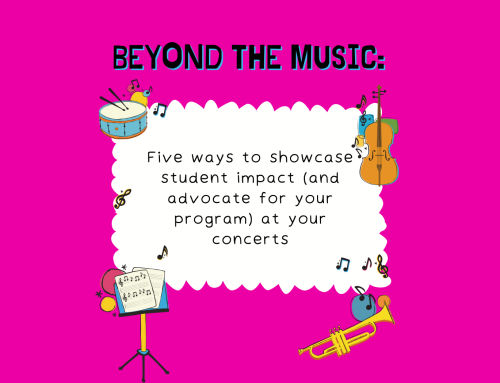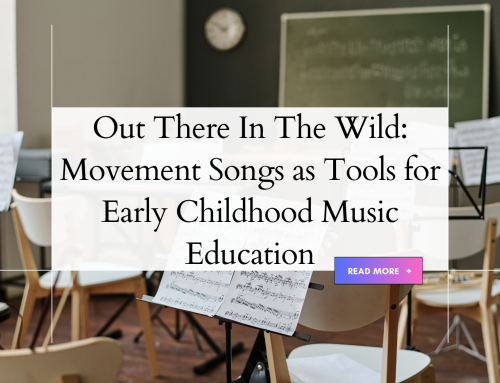Like many other music teachers, I am in the strange position of being a (sudden) virtual teacher. On March 12th, 2020, the governor for our state of Pennsylvania held a press conference in which he announced the immediate shutdown of all schools in Montgomery County, the county in which I teach.
On March 13th, I started scrambling.
I sent out a message on a large Facebook forum inviting members to share their emails with me for a large resource roundup. At the time, I was hoping to help other music teachers, like myself, navigate this new world of distance learning. Little did I know that I would be looking at potentially teaching remotely for the remainder of the school year.
Table of Contents
Re-thinking One2One
My school was One2One before the shutdown happened. This means that every student had a chromebook and we were already using platforms to create music online such as Noteflight Learn and Soundtrap. I realize now, more than ever, how privileged my district is for this to be the case. So many districts are not only working to create remote learning experiences, they are addressing huge disparities in the availability of devices and internet for many students. I see this happening in my own city, where my son attends kindergarten, and I see this happening around the country. As I present this review, I first want to mention that I’m fortunate in that my students are able to use these technologies.
Even though we’ve been One2One for a few years, my current Google Classroom and the tools we’ve been using would not be enough to reach my students remotely. Specifically, I was on the hunt for applications that could help my high school orchestra and guitar students work on improving their playing skills remotely. The two applications I opted to use were both being offered for free during COVID-19: Moosiko and SmartMusic.
(Note: I have not been sponsored to review either of these platforms and my opinions/thoughts are an honest assessment of how these tools have functioned for me personally.)
Review: Moosiko for guitar class
The founder of Moosiko contacted me shortly after I made an “all call” for resources on Facebook. He shared his platform with me and we did a quick phone chat so I could find out more about his work and his vision.
What is Moosiko?
It is a song-based guitar website in which students learn popular songs through guided practice. It is not meant to replace a guitar instructor, instead, it is meant to supplement instruction and provide students with practice tools to use outside of lessons or guitar class.
How is it different from other practice tools?
I’ve used a few different learning strategies/apps with my students, such as Yousician and YouTube tutorials. The difference with Moosiko is that it is not video-based instruction. It takes students through step-by-step manageable practice goals with the end product of learning a song. I really love this about the application because it mirrors the way that I would break down learning a song in person! Students learn the chords and chord transitions incrementally. There are even instructions in the practice steps that include “Take a break!”, encouraging students to work in a way that is research-based and effective. The song sheets are also color coded by chord, which is extremely helpful for beginning students who are struggling to know how long to hold each chord in a song.
How is Moosiko helpful to teachers?
I love that with this site, I can setup a class and see how much my students have practiced and track their skills. If they learn a new chord, I can see that! Tracking student progress is easy.
How do students feel about Moosiko?
We’ve only been using this site for a week but I’ve only gotten positive reviews at this point. Students like the practice steps and the variety of songs. I was shocked to see that some of my students logged FOUR HOURS of practice within two days of signing up. These are students that never practiced at home before. In an exit survey from class last week, I asked students what we should keep doing for future lessons and one of my advanced students wrote, “more Moosiko”. The only negative feedback I received was in relation to strumming patterns. At the moment, Moosiko does not have strumming patterns for all of their songs, only a select few (causing my students to look elsewhere to figure out the strumming pattern). However, when I reached out to Dan about this, he said they are continuing to add more each week. In the short two weeks that I’ve been on their site, I notice regular changes and upgrades. This shows me that Dan and his company are listening to the feedback they are receiving and constantly making their platform better!
Dan and I both started our businesses around the same time and we seem to have similar missions. So, I feel excited to support his site and to see how it continues to help my students. In summary, here is my honest review of Moosiko:
Pros:
- free during COVID-19
- very easy to navigate for students
- mirrors in-class instruction
- great support and communication from Dan
- research-based practice strategies
- great variety of songs
- constantly growing/changing based on feedback
Cons:
- not all songs have strumming pattern instruction
- limited library of songs from certain decades
Review: SmartMusic for orchestra
What is SmartMusic?
SmartMusic is “music learning software for educators and students. Make practicing and tracking student progress easy and fun.” It contains a library of repertoire for band, choir, and orchestra including method books, solo pieces, and large ensemble pieces. I have always wanted to use SmartMusic but due to lack of funding was unable to do so.
How is it different from other tools?
SmartMusic has integrated tools that allow students to practice, record, and receive immediate feedback on how they are performing in relation to their part. Each piece can be manipulated in terms of tempo, sensitivity, and a host of other factors that allow students to practice their music either alone or with a full backing track.
How is SmartMusic helpful to teachers?
It is hard to replicate the ensemble experience without being in an ensemble. However, this tool helps support ensemble playing through assignments directly related to personal and repertoire goals. As a teacher, I can setup my classroom and assign playing quizzes or practice goals and track student learning. I can also see a visual indicator of how students are performing on a given task.
How do students feel about SmartMusic?
I got mixed feedback after the first week of using SmartMusic. Some of my students really enjoyed using it to explore music and practice while others felt frustrated with technical difficulties. We had some login trouble (my students cannot receive external emails to their school email account), so I had to manually accept students into our SmartMusic class. In addition, students had some trouble learning how to use the software and how to record themselves playing.
I know that the potential for SmartMusic is incredible as I’ve had many friends and teachers tell me how it has transformed their ensembles. However, as a music teacher looking for new tools with little time for PD on those tools, I was disappointed in the platform. It does not feel as intuitive to me as other platforms do that I use (Noteflight Learn, Soundtrap, and Moosiko) and that was evidenced by the many emails I received from students. It seems that this is a platform I would need training in to fully use it in a way that is effective, whereas other platforms feel easy to navigate and learn quickly. I also wish there were more literature options for string orchestra. I believe that it might be better for band directors in this sense, and I was happy to see that SmartMusic had two of the pieces we were working on in class, but there is still much to add.
I did send feedback to SmartMusic about the things that disappointed me (login troubles, confusing dashboard, etc.) and I am still waiting to hear back. I’m not giving up on SmartMusic yet, but I do need to spend some time learning it better to make it work for me and my students.
Pros:
- free during COVID-19
- many different applications
- manipulation of scores/repertoire
- ability to record and listen back to playing quizzes
- practice tracking tools
Cons:
- dashboard is confusing and challenging to navigate as a new user
- students need support for using the application for the first time
- limited string orchestra library
- challenges for students with recording/submitting work
- training videos require login and signup for their system
Closing
How about you? Have you used either of these applications? And, if you’re a SmartMusic user, I’d love any advice you have! Please share in the comments below or send me an email [email protected]




[…] received an honest review from F-Flat […]